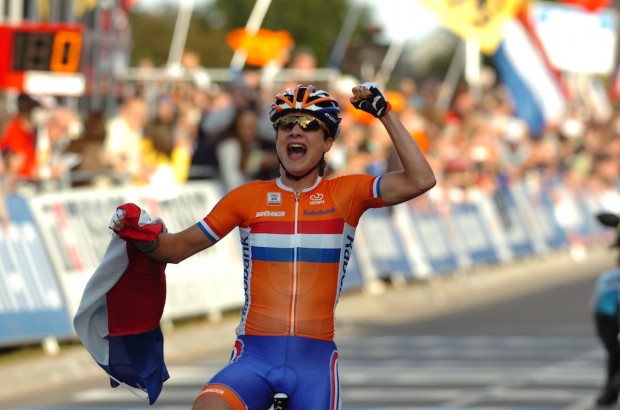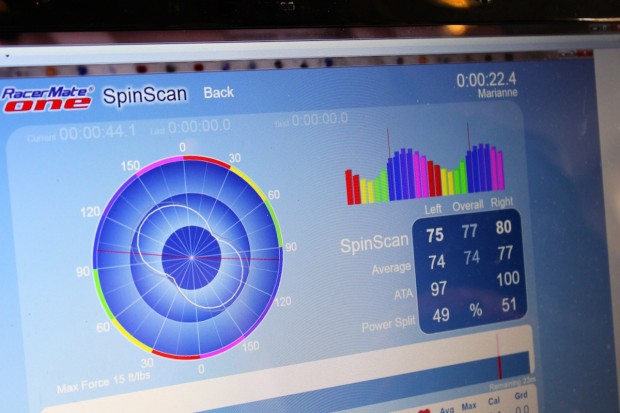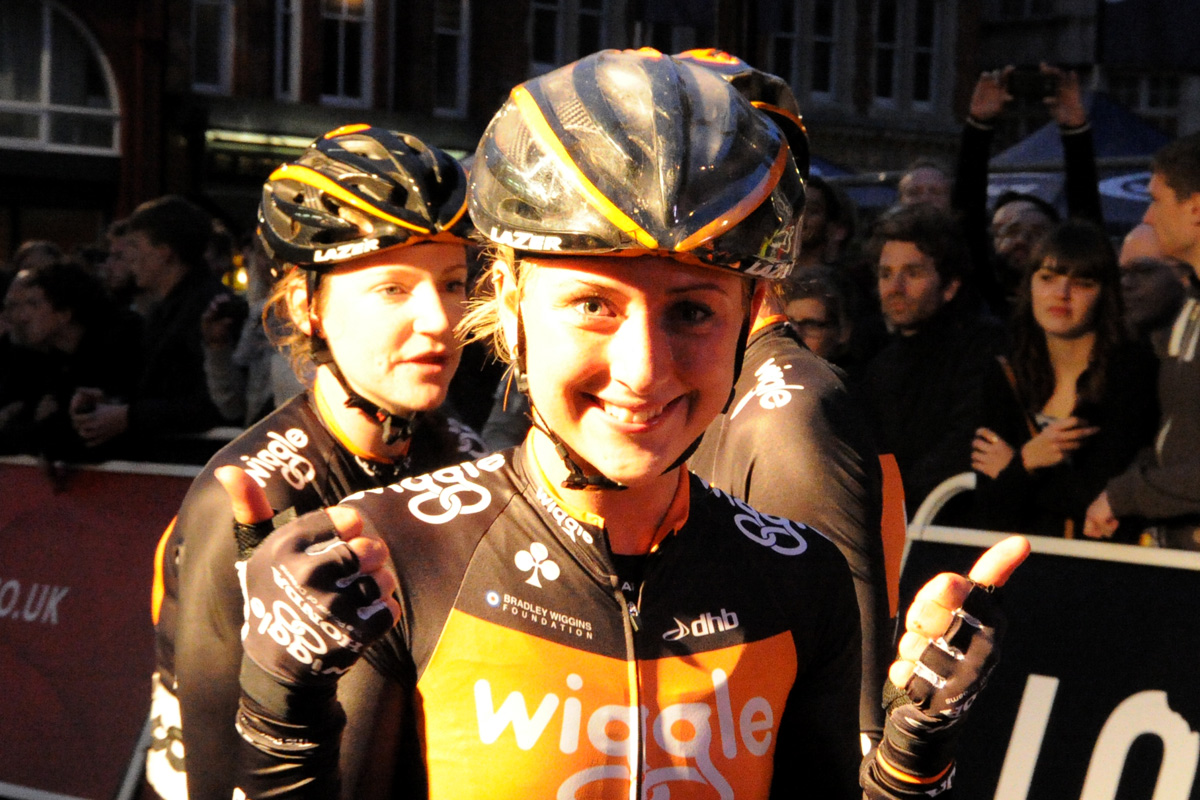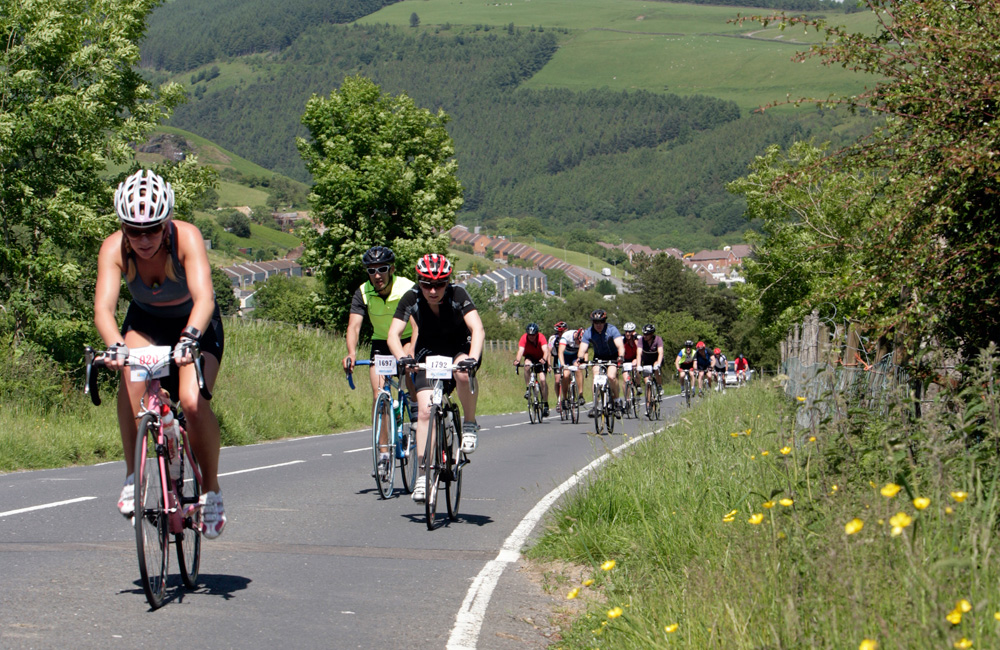To the untrained eye, Olympic road race champion Marianne Vos, a reigning and former world champion in disciplines from ‘cross to track to road, is a rider without weakness.
Christie O’Hara, however, has evidence of at least one. As team liaison for Rotor Bike Components, manufacturer of elliptical chainsets and Vos’ preferred supplier, O’Hara has data to reveal a chink in the Dutchwoman’s seemingly impregnable shield of power, speed and technique.
Vos’ ‘Spin Scan’, a computerised rendering of the world and Olympic road race champion’s pedal stroke, reveals that she is stronger in the right leg than the left. The revelation, laid out in a series of diagrams on the screen of O’Hara’s laptop, proves that even the best can improve.
“I didn’t have that much advice for her because obviously she’s amazing,” a smiling O’Hara tells RoadCyclingUK, “but if you look at some of these numbers and its not perfect. You look at the efficiencies of her left leg and right leg, you see that her right leg is a little bit stronger than her left leg. So just having her work a bit more on her left leg efficiency will help her in the long run.”
A polar graph – a circular representation with a peanut-shaped outline at its centre – gives a graphical interpretation of the Dutch champion’s minor power imbalance. The indentations represent the ‘deadspots’ in Vos’ pedal stroke. A perfectly circular outline would represent an entirely smooth pedal stroke without loss of power at any point.
Numbers on the right hand side of O’Hara’s screen spell out the same scenario in unflinching numerical form. Vos’ ‘average torque angle’ – the position of her cranks at the point where she produces most power – also differs slightly. Her stronger right leg throws out the most power at 104 degrees; her left leg produces its greatest torque at 100 degrees.
I didn’t have that much advice for Marianne Vos because obviously she’s amazing
Vos, who added a fifth world cyclo-cross title her palmares in February, and who has of late trained her sights on mountain biking, was a recent visitor to Rotor’s Madrid offices, where the Spin Scan was completed. Rotor’s new QXL chainring, one shown to RoadCyclingUK during O’Hara’s recent visit to London’s Sigma Sport, was among the devices to have caught Vos’ attention, she reveals. Power surges, one of the undesirable aspects of an inefficient power stroke, can lead to wheelspin on rough surfaces – anathema to a mountain biker.
Elliptical illusion?
Elliptical chainrings are an increasingly common sight in cycling’s elite WorldTour peloton. Bradley Wiggins used elliptical rings to win the Tour de France and Olympic time trial, and Rotor is the supplier to the Garmin-Sharp team of David Millar and Dan Martin.
O’Hara, who has a masters degree in kinesiology, with a concentration in bio-mechanics, is also the team liaison to Garmin-Sharp, and explains the philosophy of oval chainrings in simple terms.

A cyclist applies greatest pedaling force on the downstroke, but conversely generates the least force on what O’Hara calls the deadspot, typically found between “two o’clock” and “five o’clock”. Elliptical chainrings attempt to address the imbalance by placing the greatest diameter at the downstroke and the least at the so-called deadspot.
The chainring can be placed in one of five positions to ensure its varying diameter is in the right place at any given section of the pedal stroke. It’s a configuration known to Rotor as Optimum Chainring Position, and position three – one that places the Q or QXL ring’s torque angle at 108 degrees – is the recommended starting point for those new to Rotor’s elliptical rings.
“Typically, if you feel that power is occurring too early in your pedal stroke, we recommend changing to position two,” says O’Hara. “If you feel that power is occurring too late in your pedal stroke, we recommend changing to position four.”
The OCP guide provides a range of scenarios and recommended solutions (riders requiring a lower cadence to be comfortable are advised to move the position of the chainring backwards one notch, for example; those who find that steady speeds are easy to achieve are advised to move the chainring position forward one notch), but O’Hara is able to offer a deeper analysis – we return to the Spin Scan offered to Voss.
Spin Scan Analysis
“Spin Scan analysis shows the efficiency of your pedal stroke, left and right power balance, and gives you a visual representation of your pedal stroke,” says O’Hara.
“Finding your average torque angle allows you to correlate to that position on the Q-Ring. For example, position three is at 108 degrees. Using the Spin Scan analysis we could correlate the optimum position for your Q-Ring.”
Vos’ numbers are impressively high. A Spin Scan reading of 100 would represent a perfect, unbroken power output throughout the pedal stroke, an idealised scenario O’Hara describes variously as “linear” and “impossible”. The Dutchwoman’s readings are typical for those she would expect to see from a pro rider.

But do professionals need such aids? Surely those like Millar, riders who look as if they were born on a bike, achieve their effortless pedal stroke naturally? O’Hara is well placed to answer. She is also the team liaison to Millar’s Garmin-Sharp outfit.
Millar, she confirms, is “big into technology”, but even riders of his interests and ability can get better.
“Most of the guys have special talent,” O’Hara says of Garmin-Sharp, “but there’s always room for improvement. With every athlete, whether it’s material on the bike, position on the bike, aerodynamics, sports science: there’s always so much you could do.
“Every little small advantage you can get, it adds up. You can win a race by less than a second. That’s where Q-Rings come in. We really believe that.”
O’Hara’s belief in the product stems from research conducted for her master’s degree – data made publicly available in her article for the International Journal of Sports Science and Engineering in March 2012.
She measured the outputs of a group of professional cyclists in sub-maximal efforts and 1km time trials on round chain rings, on Q-Rings, and, after four weeks on the Rotor product, on conventional rings again.
She found in sub-maximal tests, designed to replicate the constant demands of a race, rather than a short, full gas effort, the riders had lower oxygen consumption and a heart rate reduced by one or two beats per minute.
In the 1km time trials, the results were still more impressive. Riders were around 1.6 seconds quicker on Q-Rings than round rings, the result of power output increased by about 6.2 per cent, or nearly 27 watts.
O’Hara’s tests with pro cyclists recorded a 6.2 per cent power increase with Q-Rings in a 1km time trial
She will meet with the Garmin-Sharp squad again at an end-of-season training camp, and work again with Robby Ketchell, the team’s highly-regarded sports scientist.
O’Hara showed us the Spanish firm’s new crank-based power metre, the 556-gram Rotor Power. Lightweight devices mount to the end of either crank arm, each containing four strain gauges, and sampling power output at 500hz, or 500 times a second. The data can be read on an ANT+ enabled device like Garmin’s Edge range of handlebar-mounted GPS computers.
By placing a device on each crank arm, it accurately reads independent power and cadence outputs, O’Hara says. The Rotor Power’s ability to read positive or negative torque output, or, put more simply, the power from any part of the pedal stroke in which the crank is not moving in a clockwise direction, is also interesting. The latter, O’Hara explains, extends to “not de-weighting your leg on the upstroke”.
The range and sophistication of performance reading tools placed at the modern cyclist’s disposal can be beguiling. Increasingly, the technology used by professional is available to the amateur. We’re hoping to test these offerings from Rotor in the months ahead. One thing, however, looks certain even at this early stage: our outputs are unlikely to match those of Vos or the Garmin-Sharp team.
Website: Rotor Bike Components
UK distributor: Rotor UK






